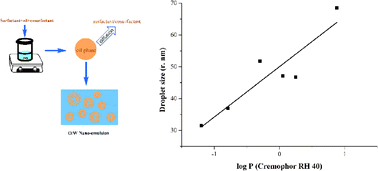Development and characterization of promising Cremophor EL-stabilized o/w nanoemulsions containing short-chain alcohols as a cosurfactant
Abstract
Nanoemulsions have attracted much attention due to their wide application in commercial industries such as pharmaceutics, food, beverages and skin care. Cremophor EL has been extensively used for emulsification, protection and solubilization of various lipophilic bioactive agents. However, their anaphylactoid hypersensitivity reactions are still challenging. Therefore, the aim of this study was to develop and characterize a promising, low-level Cremophor EL-stabilized o/w nanoemulsion using the spontaneous emulsification method for oral administration. From comparing the physicochemical properties (particle size and size distribution) of their emulsions, Cremophor has better emulsifying capacity than Tween and the droplet radius of emulsions can be reduced by increasing the surfactant concentration in current systems. The impact of various short-chain alcohols (C–OH < 5) on the formation and stability of nanoemulsions was also investigated to optimize the formulations. And there is a good correlation between nanoemulsion droplet size and the surfactant packing parameter (p). The smallest droplet size with the narrowest size distribution was produced by the system containing ethylene glycol as a cosurfactant. However, preparation of nanoemulsions with ethylene glycol was a time-consuming process since it was difficult to emulsify the water-induced gel-structure. Surfactant-to-oil mass ratio and surfactant-to-cosurfactant levels had to be optimized to produce fine droplets. Moreover, there was a linear relationship between the viscosity/log P value of alcohols and droplet size. Ostwald ripening was the dominant breakdown process of nanoemulsions obtained in the ethyl oleate/Cremophor EL–butanol (3 : 2)/water system. Ostwald ripening rate was increased with increasing surfactant concentration. Dilution (100×) of this system considerably improved their stability against droplet growth. This study demonstrated that alcohol addition might be a useful tool for preparing Cremophor EL-stabilized nanoemulsions for pharmaceutical applications.



 Please wait while we load your content...
Please wait while we load your content...